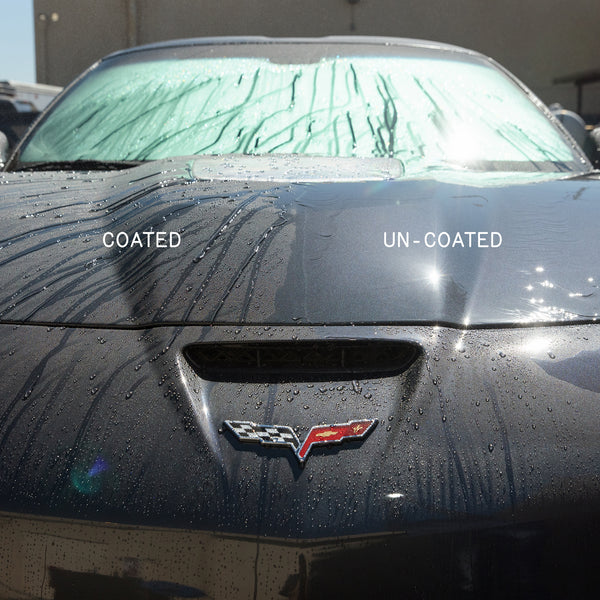Exploring the Scientific Research Behind Ceramic Finish and Its Effect on Cars And Truck Outlining
The application of ceramic finishing in vehicle detailing represents a significant improvement in vehicle care, rooted in its sophisticated chemical residential properties, mostly silica dioxide and titanium dioxide. As we check out the complexities of the application process and the long-lasting effects for automobile maintenance, it becomes clear that the selection of ceramic layer can essentially change one's approach to car treatment.
What Is Ceramic Finish?
Ceramic coating is a modern-day service that has actually acquired appeal in the vehicle detailing market for its ability to offer long-lasting defense for vehicle surface areas. This advanced safety layer is generally made up of silica dioxide (SiO2), which forms a solid bond with the vehicle's paint, producing a sturdy guard versus ecological contaminants. Unlike standard wax or sealers, ceramic finishings supply exceptional resistance to UV rays, chemical discolorations, and physical abrasions.
The application of ceramic covering includes a thorough procedure, where the car's surface area is extensively cleaned and sanitized prior to the coating is applied (Ceramic Coating). When healed, the covering improves the car's gloss, deepness, and clarity, offering a showroom-quality surface that lasts for several years. One of the essential benefits of ceramic layer is its hydrophobic homes, which drive away water and dirt, making maintenance easier and decreasing the regularity of cleans
The Chemistry of Ceramic Layer
An essential element of ceramic finish hinges on its chemical make-up, largely characterized by the existence of silica dioxide (SiO2) This substance is indispensable to the development of a sturdy, safety layer that bonds chemically to the vehicle's surface. When applied, the SiO2 particles undertake a procedure recognized as polymerization, in which they form a network of interconnected structures. This results in a robust, hydrophobic surface that fends off water and contaminants.
Along with SiO2, lots of ceramic finishings integrate titanium dioxide (TiO2) and other ingredients to boost their efficiency qualities. TiO2, for example, adds to boosted firmness and chemical resistance. The interaction in between these substances creates an unique molecular framework that uses a high level of protection versus environmental factors such as UV rays, acid rainfall, and oxidation.
Additionally, the application process usually includes a precise prep work of the surface area to guarantee ideal attachment of the layer. This chemistry not only makes sure a resilient surface however likewise boosts the aesthetic appeal of the car. Understanding the complex chemistry behind ceramic finishes is necessary for describing specialists who intend to offer remarkable security and long life for their clients' vehicles.
Benefits of Ceramic Finish
While outlining experts usually highlight the benefits of ceramic coatings, their benefits extend far beyond looks. Ceramic layers create a hydrophobic surface that fends off water, crud, and dust, substantially minimizing the regularity of laundries and the effort required to maintain a car's appearance.
Furthermore, ceramic coverings enhance the longevity of the vehicle's coating. Unlike typical waxes or sealers, which may last a few months, ceramic coatings can endure for several years, giving a lasting option for automobile care. This sturdiness translates to set you back financial savings, as proprietors are much less most likely to need frequent reapplication.
In addition, ceramic layers are immune to chemical spots and etching, which can occur from acidic materials like bird droppings or tree sap. This resistance not only preserves the lorry's appearances however also decreases prospective damage - Ceramic Coating. On the whole, the financial investment in ceramic covering offers auto owners a significant return in regards to protection, ease of upkeep, and resilient visual charm, making it an increasingly prominent choice in the world of automotive describing
Application Process Described

When the surface is adequately prepared, the ceramic layer can be used. Using an applicator pad, the professional uses the covering in tiny areas, working in a crosshatch pattern to make certain even insurance coverage.
After applying the coating, the lorry should be permitted to treat, which may take a number of hours to several days, relying on the particular item utilized. Throughout this period, it is essential to keep the lorry away from dampness and contaminants. As soon as cured, the ceramic layer develops a solid bond with the paint, offering boosted defense and a shiny coating. Proper application is important to optimize the durability and performance of the ceramic covering.

Lasting Influence on Automobile Care
The long-term influence of ceramic layer on lorry treatment is significant, as it fundamentally modifies just how owners maintain their vehicles. By developing a long lasting, hydrophobic layer on the car's surface, ceramic layers lessen the adherence of dirt, grime, and impurities. This building minimizes the regularity of washing called for, eventually conserving water and cleansing products.
Additionally, the UV defense provided by ceramic coatings aids to avoid oxidation and fading of the vehicle's paint, protecting its aesthetic charm and resale value gradually - Ceramic Coating. This protective obstacle also minimizes the likelihood of scrapes and swirl marks, which are common problems in traditional paint surfaces
Moreover, ceramic finishes facilitate much easier maintenance, enabling proprietors to clean their automobiles with minimal effort. The smooth surface area makes it challenging for impurities to bond, enabling easier elimination during regular cleansing.
Over time, the financial investment in ceramic covering might bring about cost financial savings in lorry care items and solutions. In general, the sustaining benefits of ceramic finishings not only improve the look of vehicles yet also contribute to an extra efficient and sustainable method to vehicle maintenance.
Final Thought
Finally, the application of ceramic covering represents a substantial innovation in automobile describing, driven by its unique chemical composition of silica dioxide and titanium dioxide. This innovation not only improves the visual allure of vehicles however additionally offers robust security versus ecological threats and put on. The long-term benefits, including reduced maintenance regularity and enhanced durability, underscore the value of ceramic coverings as a necessary financial investment for maintaining lorry look and honesty with time.
